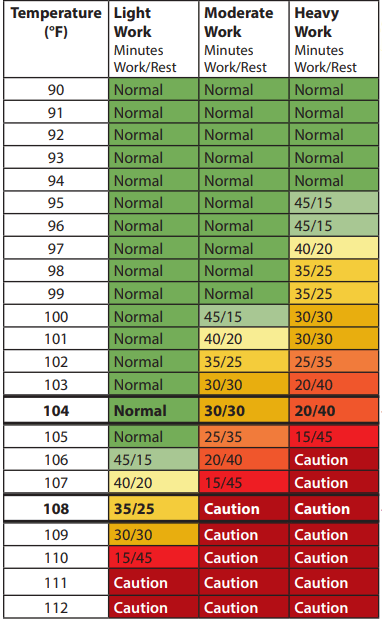 Each year thousands of workers are injured or die from heat stress they experience in the workplace. The Centers for Disease Control and Prevention (CDC) warns employers and workers of the occupational illnesses and injuries they may experience due to heat stress in the workplace.
Each year thousands of workers are injured or die from heat stress they experience in the workplace. The Centers for Disease Control and Prevention (CDC) warns employers and workers of the occupational illnesses and injuries they may experience due to heat stress in the workplace.
The Occupational Safety and Health Administration (OSHA) holds employers responsible for protecting their workers from extreme heat, and encourages a heat stress prevention program if workers are exposed to high temperatures.
What is Heat Stress?
Heat Stress occurs when the body cannot get rid of excess heat. Illnesses related to heat stress can include heat stroke, heat exhaustion, Rhabdomyolysis, dizziness, cramps, and rash. Hydration and rest are important for heat stroke prevention, but the most effective way to prevent heat stroke in an occupational setting is to implement work practice controls. CDC guidance provides recommendations on control measures for heat stress prevention by implementing engineering and work practice controls.
How To Prevent Heat Stress In The Workplace:
- Controls
- Training
- Acclimatization
- Hydration
- Rest Breaks
Controls
Employers should reduce workplace heat stress using engineering controls such as increased ventilation and air movement, use of heat shields or barriers, and reducing humidity or “wetness” in the environment.
Work practice and administrative controls can be implemented to improve heat stress safety such as limiting work time in heat and increasing time spent in a recovery environment. A heat acclimatization plan should be in place if workers are exposed to a new environment subject to high heat.
Training
Employers should provide a heat stress safety training program for workers in both indoor and outdoor conditions during hot months. Training should be tailored to the worksite-specific conditions of each task or job. Employees should learn to recognize the signs and symptoms of heat-related illness and feel comfortable with halting work if necessary. Supervisors should be trained on responding to hot weather advisories and emergency response procedures due to heat stress. Supervisors should encourage adequate fluid intake and rest breaks.
Acclimatization
An important aspect of heat stress prevention is acclimatization. The CDC defines acclimatization as the result of beneficial physiological adaptations, such as increased sweating efficiency, that occur following repeated exposure to a hot environment. Workers in new hot environments should spend 20-50% of their work day (depending on experience) exposed to high heat on the first day of the job, followed by 10-20% increases of time each day following. Some workers may have special needs based on physical fitness or respiratory conditions.
Dozens of workers die each year, and thousands become ill due to heat illness. Approximately 50-70% of fatalities from occupational heat exposure occur in the first few days of working in a new environment with warm or hot conditions. The human body needs to gradually build a tolerance to heat over time.
Hydration
Employees must have access to potable drinking water greater than 15°C (59°F) in their work area. Proper supply of water should be maintained throughout the work day and workers should be encouraged to hydrate themselves during heat exposure.
According to a National Institute for Occupational Safety and Health (NIOSH) heat stress fact sheet, the key to hydration is to drink water before one becomes thirsty. When working in hot conditions, drink one cup (8 oz.) of water every 15-20 minutes. Hydration before work, during work in hot conditions, and after work is imperative to increase hydration and prevent heat illness. Employees working in hot environments should monitor the color of their urine throughout the day to gauge their level of hydration.
Rest Breaks
Rest breaks and water breaks should be permitted and encouraged for workers exposed to hot temperature environments. Short break periods will split longer work hours into smaller chunks, and allow workers to recharge and operate more efficiently. Rest periods should be increased if temperature or humidity increase, there is no air movement, protective clothing or equipment is worn, or for “heavier work”. According to NIOSH in extreme cases of heat stress or high temperatures, even a work/rest schedule may not eliminate the risk of heat stroke of heat illness. NIOSH does not advise continuous work in heat.
Currently OSHA has no enforceable heat exposure limits in the workplaces, however, OSHA guidance states a heat index of <91°F is associated with a “lower” risk of heat related illness.
NIOSH Heat Reference Table for Work/Rest Schedule

RHP Professionals are experienced, knowledgeable, and credentialed to provide guidance for businesses implementing worker health and safety plans. Companies and businesses who adopt, promote, and seek to regularly improve their active Occupational and Environmental, Health and Safety programs and management systems are rewarded with a happier, healthier, and more productive workforce with less turnover, and lower administrative and operating costs. Contact RHP for an initial consultation or call (773) 867-6010.
